Download DSC LCD 5500 Installation manual
Transcript
PK5500 v1.1 Installation Instructions 1 2 3 4 5 6 7 8 9 * 0 # WARNING: Please refer to the System Installation Manual for information on limitations regarding product use and function and information on the limitations as to liability of the manufacturer. NOTE: These instructions shall be used in conjunction with the system Installation Manual of the Control Panel with which this equipment is intended to be used. 2 9 0 0 7 4 9 6 R0 0 1 The PK5500 keypad can be used on security systems with up to 64 zones. These keypads are compatible with the latest version of the folllowing DSC security systems: •PC580 •PC585 •PC1555MX •PC1565 •PC1616 •PC1832 •PC1864 •PC5005 •PC5008 •PC5010 •PC5015 •PC5016 •PC5020 3 Specifications • Temperature range: -10°C to +55°C (14°F to 131°F) • Humidity (MAX): 93%R.H. • Plastic enclosure protection degree: IP30, IK04 • Voltage rating: 12VDC nominal • Connects to control panel via 4-wire Keybus • 1 keypad zone input/PGM output* • PK5500 Current Draw: 50mA (standby)/125mA (maximum) • Wall mount tamper • 5 programmable function keys • Ready (Green LED), Armed (Red LED), Trouble (Yellow LED), AC(Green LED) • Low temperature sensor: Alarm 6°C (43°F)/Restore 9°C (48°F) NOTE: * Zone not to be programmed as Fire type or 24h type. NOTE: If any tension found between the front keypad assembly and wiring, please open the keypad reroute the wire and close again. Repeat these steps until the keypad is closed properly. 1 2 Wiring Mount and Wire Keypad Knock Out Knock Out Wiring Slot Knock Out Unpacking The Power keypad package includes the following parts: •One Power keypad •Keypad inner door labels •Four mounting screws •1 tamper switch •2 end-of-line resistors •Installation Instructions Tamper Hooks 2. 1. Hooks Swing to engage Mounting Mount the keypad where it is accessible to designated points of entry and exit. Once you have selected a dry and secure location, perform the following steps to mount the keypad. Disassemble Keypad 1. Insert a flat head screwdriver into the provided slot (first of two). 2. Move screwdriver toward the back plastic and lift as in the following diagram. This will unhook one side of the front plastic. 3. Repeat step # 1 and 2 on the second provided slot to disconnect the front plastic and allow access for wiring. 1. Secure Keypad to wall using mounting holes. Use all 4 screws provided unless mounting on a single gang box. 2. Place keypad into hooks on the backplate and swing down to engage. 3. Run wire through wiring slot or knockouts. Connect Keybus and PGM/Zone wiring to keypad. Place tamper switch into tamper hole on backplate. 4. Remove keypad from hooks. Place keypad into backplate, ensure the wire is pushed back into the wall as much as possible. Route the wire inside the keypad ensuring high components are avoided. Snap the front assembly closed, ensuring there is no pressure to the keypad from the wire below. 3. 4. Tamper Press to Snap 1. Before wiring the unit, ensure that all power (AC transformer and battery) is disconnected from the control panel. 2. Connect the four Keybus wires from PK5500 the control panel (red, black, yellow RED and green) to the keypad terminals. Refer to diagram. BLK YEL 3. If programmed as an input, you can connect a device - such as a door GRN contact - to the ‘P/Z’ terminal of the To zone or keypad. This eliminates the need to PGM output run wires back to the control panel for the device. To connect the zone, run one wire from the device to the ‘P/Z’ terminal and the other wire from the device to the B (black) terminal. For powered devices, run the red wire to the R (positive) terminal and the black wire to the B (negative) terminal. When using end of line supervision, connect the zone according to one of the configurations outlined in your system’s Installation Manual. 4. If the ‘P/Z’ terminal is programmed as an output, the output follows the PGM programmed in Section [080]. A small relay, buzzer or other DC operated device may be connected between the positive supply voltage and the ‘P/Z’ terminal (maximum load is 50mA). Applying Power Once all wiring is complete, and the equipment is secured to the building structure with at least two screws apply power to the control panel: 1. Connect the battery leads to the battery. 2. Connect the AC transformer. For more information on control panel power specifications, see the control panel Installation Manual. Programming the Keypad There are several programming Toggle Option options available for the keypad. These are described below. Pro1_ _ 4 _ _ _ _ gramming the keypad is similar to programming the rest of the system. When you are in the keypad programming sections, the keypad will display which options are turned on along the top of the display. To turn an option on or off, press the number corresponding to the option on the number pad. The numbers of the options that are currently turned ON will be displayed. For example, if options 1 and 4 are on, the display will look like diagram shown on the different keypad displays. For information on programming the rest of your security system, please refer to your system’s Installation Manual. Broadcasting LCD Labels All LCD programming is done per keypad. If more than one LCD keypad is present on the system, labels programmed at one keypad can be broadcast to all other LCD keypads. Perform the following procedure in order to broadcast labels: Step 1 - Program one LCD keypad completely. Step 2 - Make sure all LCD keypads are connected to the Keybus. Step 3 - Enter keypad programming by pressing [,][8][Installer Code][,], then enter section [998] at the keypad that was programmed. The keypad will now broadcast all the information programmed to all the other LCD keypads on the system. Step 4 - When the keypad is finished press the [#] key to exit. NOTE: LCD Label broadcast from this keypad is only compatible with other PK5500 keypads. Language Programming Hold (<>) keys for 2 seconds to enter language programming, scroll to the desired language and Press [,] to select. NOTE: If section [077] option 4 is OFF, language programming can only be performed while in installers programming. Enrolling the Keypad The keypad will need to be assigned to a partition and slot if supervision or keypad zones are being used. Keypad assignments and keypad option programming must be done at each keypad individually. The 1st digit of keypad assignment is used to determine partition assignment (1 to 8). If partitioning is not used, enter [1]. For Global Keypads, enter [0]. The 2nd digit of keypad assignment is used to determine slot assignment for keypad supervision. Each keypad will be assigned a different slot number from 1 to 8. PK5500 LCD keypads come defaulted in slot 8. If LCD keypads are used one LCD keypad must remain in slot 8. Enter the following at each keypad installed on the system: 1. Enter Installer Programming by pressing [,][8][Installer’s Code] 2. Press [000] for Keypad Programming 3. Press [0] for Partition and Slot Assignment 4. Enter the 1st digit (0 to 8 for partition assignment) 5. Enter the 2nd digit (1 to 8 for slot assignment supervision) 6. Press the [#] key twice to exit programming. 7. After assigning all keypads, perform a supervisory reset by entering [,][8][Installer’s Code][902] and wait for 60 seconds. 8. Press the [#] key to exit programming after 60 seconds. Changing Brightness/Contrast Programming Labels 1. Press [,][6][Master Code]. 2. Use the [<][>] keys to scroll to Buzzer Control. 3. There are 21 different levels, use the [<][>] keys to scroll to the desired level. 4. To exit, press [#]. 1. Enter keypad programming by pressing [,][8][Installer Code][,]. Enter the 3-digit section number for the label to be programmed. 2. Use the arrow keys (<>) to move the underline bar underneath the letter to be changed. 3. Press the number keys [1] to [9] corresponding to the letter you require. The first time you press the number the first letter will appear. Pressing the number key again will display the next letter. 1. Press [,][6][Master code]. 2. Use the [<][>] keys to scroll to either Brightness Control or Contrast Control. 3. Press [,] to select the setting you want to adjust. 4. a) ‘Brightness Control’: There are multiple backlighting levels. Use the [<][>] keys to scroll to the desired level. b) ‘Contrast Control’: There are 10 different display contrast levels. Use the [<][>] keys to scroll to the desired contrast level. 5. To exit, press [#]. Changing the Buzzer Level Emergency Keys [1] - A, B, C, 1 [4] - J, K, L, 4 [7] - S, T, U, 7 [0] - Space Press the ( ) key for 2 seconds to send a Fire transmission. Press both ( ) keys simultaneously for 2 seconds to send a Panic transmission. [2] - D, E, F, 2 [5] - M, N, O, 5 [8] - V, W, X, 8 Broadcasting Door Chime [3] - G, H, I, 3 [6] - P, Q, R, 6 [9] - Y, Z, 9,0 4. When the required letter or number is displayed use the arrow keys (<>) to scroll to the next letter. 5. When you are finished programming the Zone Label, press the [,] key, scroll to “Save,” then press [,]. 6. Continue from Step 2 until all Labels are programmed. ASCII Characters All door chime programming is done per keypad. If more than one keypad is present on the system, door chime programmed at one keypad can be broadcast to all other keypads. Perform the following procedure in order to broadcast door chime: Step 1 - Program one keypad completely. Step 2 - Make sure all keypads are connected to the Keybus. Step 3 - Enter keypad programming by pressing [,][8][Installer Code][,], then enter section [994] at the keypad that was programmed. The keypad will now broadcast all the door chime information programmed to all the other keypads on the system. Step 4 - When the keypad is finished press the [#] key to exit. Limited Warranty Digital Security Controls warrants that for a period of 12 months from the date of purchase, the product shall be free of defects in materials and workmanship under normal use and that in fulfilment of any breach of such warranty, Digital Security Controls shall, at its option, repair or replace the defective equipment upon return of the equipment to its repair depot. This warranty applies only to defects in parts and workmanship and not to damage incurred in shipping or handling, or damage due to causes beyond the control of Digital Security Controls such as lightning, excessive voltage, mechanical shock, water damage, or damage arising out of abuse, alteration or improper application of the equipment. The foregoing warranty shall apply only to the original buyer, and is and shall be in lieu of any and all other warranties, whether expressed or implied and of all other obligations or liabilities on the part of Digital Security Controls. Digital Security Controls neither assumes responsibility for, nor authorizes any other person purporting to act on its behalf to modify or to change this warranty, nor to assume for it any other warranty or liability concerning this product. In no event shall Digital Security Controls be liable for any direct, indirect or consequential damages, loss of anticipated profits, loss of time or any other losses incurred by the buyer in connection with the purchase, installation or operation or failure of this product. WARNING: Digital Security Controls recommends that the entire system be completely tested on a regular basis. However, despite frequent testing, and due to, but not limited to, criminal tampering or electrical disruption, it is possible for this product to fail to perform as expected. Important Information: Changes or modifications not expressly approved by Digital Security Controls could void the user’s authority to operate this equipment. EN50131-1 Grade 2, Class II Operating Instructions shall be made available to the end user. © 2008 Digital Security Controls, Toronto, Canada • www.dsc.com Technical Support: 905-760-3036 Printed in Canada Keypad Enrollment Enter keypad programming by pressing [,][8][Installer’s Code][000]. [0] Partition / Slot Assignment Digit 1st 2nd Option Partition Assignment (0=Global Keypad) Slot Assignment Valid Range 0 to 8 1 to 8 Default 1 8 I________I I________I [1]-[5] Function Key Assignment [1] Function Key Function Key 1 Assignment [2] Button Valid Range 00 to 32 Default 03 Function Stay Arm I________I________I Function Key 2 Assignment 00 to 32 04 Away Arm I________I________I [3] Function Key 3 Assignment 00 to 32 06 Chime On/Off I________I________I [4] Function Key 4 Assignment 00 to 32 14 Sensor Reset I________I________I [5] Function Key 5 Assignment 00 to 32 16 Quick Exit I________I________I Keypad Function Keys Refer to your system installation manual for a complete list of all function key options available for your system. [00] - Null [08] - Bypass Mode [16] - Quick Exit [01] - Partition 1 Select [09] - Trouble Display [17] - Activate Stay/Away [02] - Partition 2 Select [10] - Alarm Memory [18] - *Global Away Arm [03] - Stay Arm [11] - User Programming [19] - Command Output 3 [04] - Away Arm [12] - User Functions [21] - Command Output 4 [05] - No Entry Arm [13] - Command Output 1 [22] - *Global Disarming [06] - Chime On/Off [14] - Command Output 2 [23] - Bypass Recall [07] - System Test [15] - *Global Stay Arm [24] - Bypass Group Recall *Available only on the PC1616/PC1832/PC1864 version 4.2 or higher. [26] - Time & Date Program [27] - Partition 3 Select [28] - Partition 4 Select [29] - Partition 5 Select [30] - Partition 6 Select [31] - Partition 7 Select [32] - Partition 8 Select [33] - Local PGM Activate Keypad Programming Enter keypad programming by pressing [,][8][Installer Code][,] [001]-[064] Zone Label 1 to 64 ex. For Zone 1 enter section [001], for Zone 2 enter section [002] etc. Default: “Zone 1” - “Zone 64” Section Zone [001] to [064] 1 to 64 Label I_____I_____I_____I_____I_____I_____I_____I_____I_____I_____I_____I_____I_____I_____I I_____I_____I_____I_____I_____I_____I_____I_____I_____I_____I_____I_____I_____I_____I [065] Fire Alarm Label (28 Characters) Default:“Fire Zone” I_____I_____I_____I_____I_____I_____I_____I_____I_____I_____I_____I_____I_____I_____I [065] I_____I_____I_____I_____I_____I_____I_____I_____I_____I_____I_____I_____I_____I_____I [066] Fail to Arm Event Message Default: “System Has Failed to Arm” I_____I_____I_____I_____I_____I_____I_____I_____I_____I_____I_____I_____I_____I_____I [066] I_____I_____I_____I_____I_____I_____I_____I_____I_____I_____I_____I_____I_____I_____I [067] Alarm When Armed Event Message Default: “Alarm Occurred While Armed < >” I_____I_____I_____I_____I_____I_____I_____I_____I_____I_____I_____I_____I_____I_____I [067] I_____I_____I_____I_____I_____I_____I_____I_____I_____I_____I_____I_____I_____I_____I [071] First User Display Mask Default ON ON ON ON OFF OFF OFF OFF I____I I____I I____I I____I I____I I____I I____I I____I Option 1 2 3 4 5 6 7 8 ON Hold [P]anic Key prompt ON Auto-arm Control/Time prompt ON Quick Arm prompt ON Interior Arm prompt ON Quick Exit prompt ON Thermostat Control prompt ON ACK All Trouble Prompt ON Music Input prompt ON OFF Hold [P]anic Key prompt OFF Auto-arm Control/Time prompt OFF Quick Arm prompt OFF Interior Arm prompt OFF Quick Exit prompt OFF Thermostat Control prompt OFF ACK All Trouble Prompt OFF Music Input prompt OFF Option 1 2 3 4 5 6 7 8 ON User-initiated Call-up prompt ON For Future Use Walk Test prompt ON Command Output#1 prompt ON Command Output#2 prompt ON Command Output#3 prompt ON Command Output#4 prompt ON For Future Use OFF User-initiated Call-up prompt OFF [072] Second User Display Mask Default ON OFF OFF ON ON OFF OFF OFF I____I I____I I____I I____I I____I I____I I____I I____I Walk Test prompt OFF Command Output#1 prompt OFF Command Output#2 prompt OFF Command Output#3 prompt OFF Command Output#4 prompt OFF [073] Download LCD Message Duration Default: 003 I_______I_______I_______I (Valid entries are 000-255), 000=Unlimited Message Disp. This number represents the number of times the downloaded message is cleared by pressing any key while the message is up after timeout). [074] Key Options Default ON ON ON OFF I____I I____I I____I I____I Option 1 2 3 4-8 ON [F]ire Key Enabled For Future Use [P]anic Key Enabled For Future Use OFF [F]ire Key Disabled [P]anic Key Disabled [076] First Keypad Options Default ON ON OFF ON OFF ON OFF OFF Option ON I____I 1 Display Code when Programming I____I 2 Local Clock Display ON I____I 3 Local Clock Displays 24-hr Time I____I 4 Auto Alarm Memory Scroll Enabled I____I 5 Local Display of Temperature ON I____I 6 Bypass Options prompt ON I____I 7 For Future Use I____I 8 Auto-Scroll Open Zones ON [077] Second Keypad Options Default Option ON ON I____I 1 Chime Enabled for Zone Openings ON I____I 2 Chime Enabled for Zone Closings OFF I____I 3 5th Terminal is Keypad PGM Output ON I____I 4 Language Selection Enabled OFF I____I 5 Power LED Enabled ON I____I 6 Power LED indicates AC present ON I____I 7 Alarms always Displayed When Armed OFF I____I 8 *Low Temperature Warning Enabled *The Low Temperature Warning is violated at 6°C (43°F) and restored at 9°C (48°F). OFF Display “Xs” when Programming Local Clock Display OFF Local Clock Displays AM/PM Auto Alarm Memory Scroll Disabled Local Display of Temperature OFF Bypass Options prompt OFF Auto-Scroll Open Zones OFF OFF Chime Disabled for Zone Openings Chime Disabled for Zone Closings 5th Terminal is Keypad Zone Input Language Selection Disabled Power LED Disabled Power LED indicates AC absent Alarms not Displayed When Armed Low Temperature Warning Disabled [080] PGM Terminal 1 Default: 01 I_______I_______I 1-14 Follow PGM Output Number, 15 Local PGM Pulse , 16 Local PGM Toggle [082] Local PGM Output Pulse Activation Time Default: 00 I_______I_______I Minutes (Valid Range 00-99) Default: 05 I_______I_______I Seconds (Valid Range 00-99) [101]-[108] Partition Labels ex. For Partition 1 enter section [101], for Partition 2 enter section [102] etc. Section Partition [101] to [108] 1 to 8 Label I_____I_____I_____I_____I_____I_____I_____I_____I_____I_____I_____I_____I_____I_____I I_____I_____I_____I_____I_____I_____I_____I_____I_____I_____I_____I_____I_____I_____I NOTE: Partition 1 Label is also used as the System Label. [120]-[151] Command Output Labels Default: “Command_O/P_1” - “Command_O/P_4” For Partition 1 Command O/P 1 to 4 enter [120] to [123] For Partition 2 Command O/P 1 to 4 enter [124] to [127] For Partition 3 Command O/P 1 to 4 enter [128] to [131] For Partition 4 Command O/P 1 to 4 enter [132] to [135] Section [120]-[151] For Partition 5 Command O/P 1 to 4 enter [136] to [139] For Partition 6 Command O/P 1 to 4 enter [140] to [143] For Partition 7 Command O/P 1 to 4 enter [144] to [147] For Partition 8 Command O/P 1 to 4 enter [148] to [151] Cmd. Output Part 1to8 Label I_____I_____I_____I_____I_____I_____I_____I_____I_____I_____I_____I_____I_____I_____I 1to4 I_____I_____I_____I_____I_____I_____I_____I_____I_____I_____I_____I_____I_____I_____I [201]-[264] Door Chime Sound Programming You can program the keypad to make up to four different door chime sounds for individual zones. ex. For Zone 1 enter section [201], for Zone 2 enter section [202] etc. Default Option ON ON I____I 1 6 Beeps OFF I____I 2 “Bing-Bing” Sound OFF I____I 3 “Ding-Dong” Sound OFF I____I 4 Alarm Tone OFF I____I 5-8 For Future Use OFF Disabled Disabled Disabled Disabled [994][,] Initiate Global Keypad Chime Broadcast [995][,] Reset Keypad Options to Factory Default [996][,] Label Default [997] View Software Version [998][,] Initiate Global Label Broadcast [999][,] Reset Keypad EEPROM to Factory Defaults Keypad Display Symbols 2 1 8 9 2 1 3 4 5 6 12 7 11 10 8 7 1 Fire – Indicates that there are fire alarms in memory. 2 Memory – Indicates that there are alarms in memory. 3 Ready Light (green) – If the Ready light is on, the system is ready for arming. 4 Armed Light (red) – If the Armed light is on, the system has been armed successfully. 5 System Trouble – Indicates that a system trouble is active. 6 AC – Indicates that AC is present at the main panel. 7 Program – Indicates that the system is in Installer’s Programming, or the keypad is busy. 8 Bypass – Indicates that there are zones automatically or manually bypassed. 9 For Future Use 10 Arm Mode – Indicates the mode the panel is armed in. Stay – Indicates that the panel is armed in the Stay Mode. It will turn on at the beginning of the Exit Delay Away – Indicates that the panel is armed in the Away Mode. It will turn on at the beginning of the Exit Delay 11 Chime – This icon turns on when Door Chime is enabled on the system and will turn off when Door Chime is disabled. – When zones are opened, this icon will turn on, and 7 segment displays 1 and 2 will scroll 12 Open through the open zones.








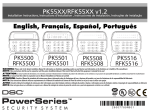
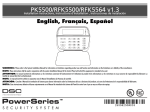
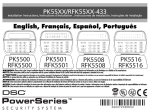
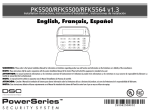

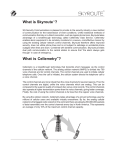
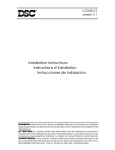
![LCD5501Z v2-1 im [all] en fr sp 29006002 r001.book](http://vs1.manualzilla.com/store/data/006343065_1-1a60305af960accbcf147395c4481cc7-150x150.png)


